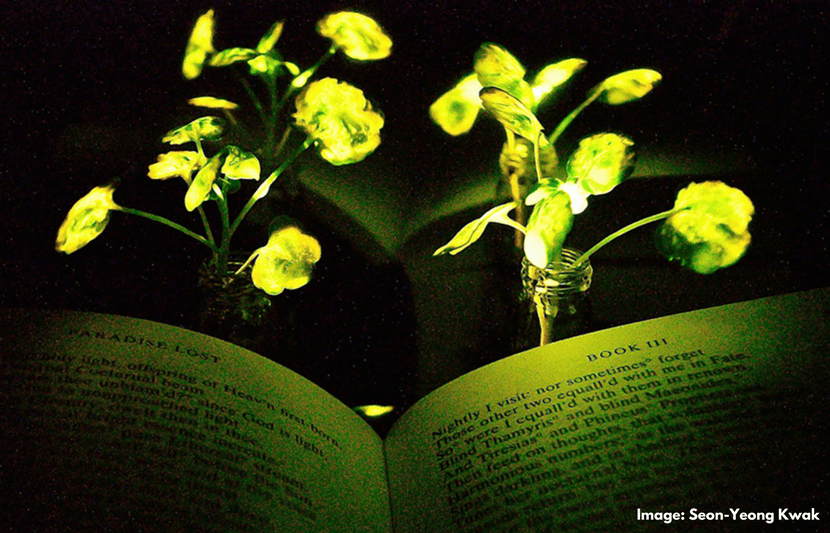MIT researchers have successfully engineered plants that glow in the dark by embedding the leaves with specialized nanoparticles.
This new technology, the researchers believe, could be optimized and lead to plants being our sources of light. So, one day we won’t be needing a desk lamp or streetlights. Instead, we could be reading by the side of a glowing plant and taking walks on pathways illuminated by glowing trees.
The study is published in NANO Letters.
The researchers have already been able to induce a watercress plant to give off dim light for almost four hours.
“The vision is to make a plant that will function as a lamp that you don’t have to plug in,” said MIT postdoc Seon-Yeong Kwak, the lead author on the study. “The light is ultimately powered by the energy metabolism of the plant itself.”
Plant nanobionics is a new research area pioneered by Michael Strano, the Carbon P. Dubbs Professor of Chemical Engineering at MIT and the senior author of the study, and his team. Their overarching goal is to engineer plants that can perform many of the functions currently carried out by electrical devices.
The researchers have previously used plant nanobionics to create plants that detect explosives and monitor drought conditions.
Since lighting accounts for nearly 20 percent of worldwide energy consumption, the researchers deem lighting to be a necessary new target for plant nanobionics to tackle.
“Plants can self-repair, they have their own energy, and they are already adapted to the outdoor environment,” Strano said in a statement.
We think this is an idea whose time has come. It’s a perfect problem for plant nanobionics.
The researchers used three components to create their glowing plants: luciferase, an enzyme that causes fireflies to glow; luciferin, a molecule to which luciferase reacts and causes it to emit light; and coenzyme A, a molecule that eliminates a reaction by-product that can inhibit luciferase activity, so the process moves smoothly.
Each component has its own nanoparticle carrier, which differs from one another in type and size, and is designed to ensure that the component gets to the right part of the plant and does not reach toxic levels. These nanoparticles are made of materials that have been classified as “generally regarded as safe” by the U.S. Food and Drug Administration.
“To create nanobionic light-emitting plants, plants were submerged in a pressurized chamber containing a nanoparticle suspension, allowing the particles to enter the leaves through tiny pores called stomata,” said Kwak.
So far, the researchers have successfully modified 10-centimeter watercress, arugula, spinach, and kale plants, though the method can be used on any type of plant.
Currently, the light generated by one 10-centimeter plant is about one-thousandth of the amount needed to read by, but the researchers believe they can boost the strength of light emitted as well as the duration by further optimizing the concentration and release rates of the components.
Their early efforts yielded plants that could glow for just 45 minutes, which they’ve since increased to 3.5 hours.
The researchers plan on developing the technology to make it possible to use larger plants and even trees as light sources by painting or spraying nanoparticles directly onto the plant leaves.
“Our target is to perform one treatment when the plant is a seedling or a mature plant, and have it last for the lifetime of the plant,” Strano said in a statement. “Our work very seriously opens up the doorway to streetlamps that are nothing but treated trees, and to indirect lighting around homes.”
The researchers have also demonstrated that they can turn the plants light off by adding nanoparticles carrying a luciferase inhibitor. Their next step is to create plants that can shut off their light emission in response to environmental conditions such as sunlight, Kwak said.
“Plant-based lighting would be a tremendous and profoundly impactful global energy revolution,” said Kwak. “We envision a new platform and model for ambient lighting that is formed, grown, deployed and composted in a natural infrastructure that is safe, renewable and compostable at end of life.”



